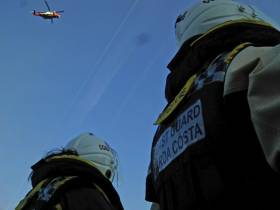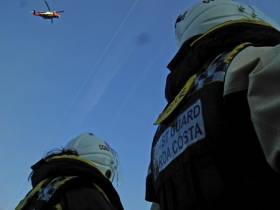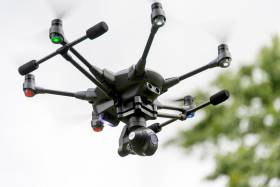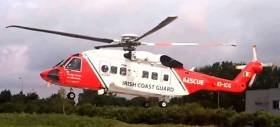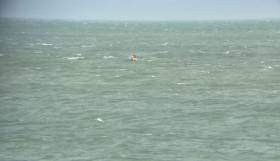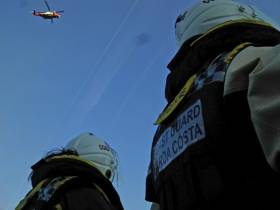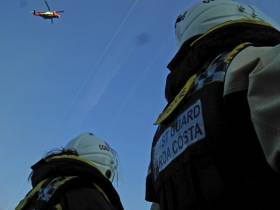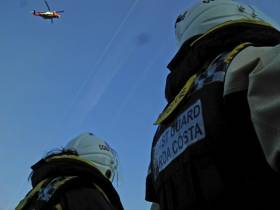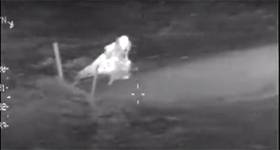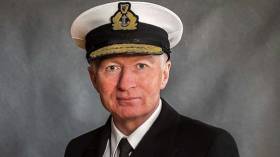Displaying items by tag: Irish Coast Guard
Stay Back, Stay High, Stay Dry Over Christmas Says Irish Coast Guard
#Coastguard - Stay Back, Stay High, Stay Dry is the message from the Irish Coast Guard to the public over the Christmas holiday period.
Many people will be engaging in outdoor activities along the coastline, be it on exposed coasts, cliffs, piers, harbour walls, beaches, promenades or other coastal areas.
And with the risk of stormy weather returning for Christmas Day tomorrow, after yesterday’s blustery conditions from Storm Barbara, the coastguard asks that anyone planning activities on or near the water to first check that it is safe to do so, and to be mindful of the risks and life threatening dangers that can arise without warning.
Christmas Day swims are a popular pursuit, and the coastguard is urging the public to only participate in organised swims where medical support and lifeguards are available.
Lone swimming should be avoided and all swimmers should be cognisant that time in the water should be kept to a minimum as even the most experienced of swimmers can easily succumb to cramp or cold water shock.
A general improvement in weather conditions is forecast from St Stephen’s Day — but spring tides that generate higher tides will peak in the latter part of the week and pose an additional risk.
The three Coast Guard Rescue Co-ordination Centres based in Malin, Valentia and Dublin, along with the coastguard helicopter service and volunteer units, will remain operational over the holiday period.
The Irish Coast Guard wishes to remind the public that if you see anybody in danger at sea, on the coast or on cliffs, call 112 and ask for the coastguard.
Anyone finding themselves involved in an emergency can use phone apps to help give their location to rescue personnel, as previously reported on Afloat.ie.
Coastguard Volunteers Want Safeguards From Government
#Coastguard - Coastguard volunteers are calling for the service to be designated as a ‘standalone primary response agency’, as the Irish Examiner reports.
A four-person delegation representing some 1,000 volunteers with the Irish Coast Guard pleaded their case with front bench TDs at Leinster House last week for the search and rescue side of the service to be safeguarded along the lines of the Garda, ambulance and fire services.
Among their complaints, the volunteers cite political manoeuvring at the expense of the service, along with “decisions being made by managers” in the Department of Transport “who have no direct involvement with the emergency services”.
In other coastguard news, volunteers from the Doolin unit were involved in the recovery of the body of a woman following a three-day search off the Cliffs of Moher. The Irish Examiner has more on the story HERE.
Drone Revolution For Search & Rescue Around Ireland’s Coast
#Drones - Remote-piloted aircraft or ‘drones’ could revolutionise search and rescue operations around the Irish coast, as the Southern Star reports.
Following a demonstration by Civil Defence Ireland to West Cork emergency services last week, the Irish Coast Guard and others are now exploring how to utilise drone technology in their SAR efforts.
“It’s an ideal resource in areas like West Cork where you have a lot of upland terrain and rocky headlands as well as huge stretches of coastline,” said civil defence officer Niall Twomey.
“The drone can get into these places much faster than searchers on the ground and do it safely too so it can be a huge assistance.”
Twomey is part of a new project developing drone-based search teams across Ireland, two of which are based in Cork at Skibbereen and Kinsale, utilising the heavy-duty Typhoon H remote-piloted aircraft.
The Southern Star has more on the story HERE.
Successful Long-Range Medevac By Sligo Coastguard Helicopter
#Coastguard - Early this morning the Sligo-based Irish Coast Guard helicopter completed the medical evacuation of an injured crewman from a large tanker some 350km off Eagle Island in Co Mayo.
The overnight operation was jointly co-ordinated with the UK Coastguard who had initially been alerted by the tanker, which is on a transatlantic voyage to the Orkney Islands.
Weather conditions on scene were described as reasonable with northwesterly winds of up to 40km per hour.
The injured crewman was airlifted by Rescue 118 shortly before 8am, and the helicopter was due back in Sligo before 10.30am for transfer of the casualty to Sligo University Hospital.
Howth Rescue Teams Launch To Lone Kayaker
#Rescue - Howth’s coastguard and lifeboat teams launched to the rescue of a lone kayaker off the North Dublin headland yesterday morning (Wednesday 28 September).
After a concerned onlooker called 999 when spotting that the kayaker was on the water with no life jacket, Howth Coast Guard and Howth RNLI’s inshore lifeboat were both tasked to the scene near Ireland’s Eye.
In the meantime the kayaker had proceeded around the back of the island and out of visibility from the caller on land. While the kayaker didn’t appear in difficulty, there were concerns for their safety.
A coastguard mobile unit proceeded to the end of the pier while the lifeboat launched on service to the far side of Ireland’s Eye, where the crew located a female on an open-deck kayak struggling in the water. She was brought back ashore by the lifeboat without incident.
“If she fell in the water, she had no means of staying afloat as she had no life jacket and only had a phone to call for help, there can be very limited if any phone signal once you go on the water,” according to an Irish Coast Guard spokesperson.
“The kayaker hadn’t checked the weather, which was unsuitable for the craft she was in. The lessons learnt are you need to have an emergency plan if going on the water – VHF radio, flares, whistle, weather information.
“Equally if not more important, you need a life jacket, no excuse.”
The rescue came just hours after Larne RNLI launched to assist two kayakers in difficulty off the Co Antrim coast, as previously reported on Afloat.ie.
Body Recovered In Search For Missing Teacher Off Kilkee
#Kilkee - BreakingNews.ie reports that a body was recovered yesterday (Saturday 24 September) off Kilkee in the search for missing teacher David McMahon.
Hundreds had been involved in the search for the school teacher, who was last seen on 9 September, according to Independent.ie.
The discovery yesterday afternoon came 12 days after the death of Irish Coast Guard volunteer Caitriona Lucas in the same area.
That tragedy occurred when the RIB she and two other coastguard volunteers were on board was flipped over in a heavy swell, three days into the search operation for McMahon off the Co Clare coast.
Donnelly Demands Update On Greystones Coastguard Upgrades
#Coastguard - Wicklow TD Stephen Donnelly has called for an update on promised upgrades to Greystones coastguard station, as the Wicklow Times reports.
The former Social Democrats co-leader said the Co Wicklow town's Irish Coast Guard base is the only facility at the new marina that has seen no redevelopment work.
"Construction on a new building for the unit was set to begin in 2015, but to date there has been no action," said Donnelly last month.
"I have requested that the OPW provide an update or progress so far."
The new Greystones Sailing Club premises was officially opened this summer just months after new leases were signed for the harbour's angling, rowing, diving and Sea Scouts tenants.
Coastguard Member Dies During Search Off Kilkee
#Coastguard - RTÉ News is reporting that a member of the Irish Coast Guard has died after a rescue boat overturned during a search for a man missing of Kilkee this afternoon (Monday 12 September).
Two other coastguard crew were recovered from the water and taken to hospital after the RIB all three were onboard flipped over in a heavy swell.
More on this story as it develops.
Rescued Yachtsman Repeats Tribute To Coastguard Saviours After Irish Sea Ordeal
#Rescue - The French sailor rescued from the hull of his upturned yacht off the Wexford coast this summer has again paid tribute to the Irish Coast Guard crew who came to his aid.
As previously reported on Afloat.ie, yachtsman Jean Conchaudron was plucked from the sea after keel failure led to him capsizing en route from Cornwall to Dublin on the night of Tuesday 26 July.
Quick-thinking Conchaudron activated his personal locator beacon, or PLB, after scrambling out of the water onto the upturned hull.
That action immediately notified the UK coastguard, who alerted their Dublin-based counterparts who in turn sent the Wexford-based SAR helicopter Rescue 117 to his location.
It was winchman Adrian O'Hara who was the first to greet Conchaudron as he lifted him from the boat to safety, as the Irish Mirror reports.
And the experienced French solo sailor said it was literally a matter of life and death before O'Hara and his fellow Rescue 117 crew arrived.
“Thank you my friend! These are my first words, the only words that come to me," he said. "I have a friend, a true friend, someone who is ready to risk his life and those of his friends, every day for an ordinary guy like me.”
In other coastguard news, TheJournal.ie has an in-depth feature following a day in the life of Rescue 117's chief pilot Mark McDermott, who joined the Waterford-based crew after retiring fro the Royal Navy in 2005.
“Every job we do is challenging in a different way,” he says. "We could be on a mountain rescue, managing an effective hover in massive up and down drafts, or we could be out to sea evacuating a cardiac patient from a boat and getting them to hospital, or we could be carrying a child with meningitis to hospital.
"You never know what you’ll be doing."
#Coastguard - Irish Coast Guard director Chris Reynolds has been seconded to Somalia as part of an EU maritime security mission in the Horn of Africa.
Reynolds was granted special leave to take the position with EUCAP Nestor based in the Kenyan capital Nairobi from on 19 July – the first time that the Irish Coast Guard has been involved in an overseas mission.
The role involves assisting local authorities with setting up their own coastguard service in a region that's been beleaguered by maritime piracy in recent years.
Ireland's coastguard chief is responsible for all operations and field offices of the EUCAP Nestor mission between Mogadishu, Puntland and Somaliland, as well as a training base in Djibouti.
Reynolds will return to his Irish Coast Guard post after his secondment, which the Department of Transport says will last around two years "subject to how the mission evolves".
Speaking of his appointment, Reynolds said: "I believe this is a recognition, on an international level, that we in the IrCG, both volunteer and professional, do a good job and that we have gained the respect and trust of all the communities we serve and all the partners we work with.”


























